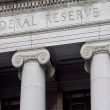by Kevin Flanagan, Head of Fixed Income Strategy, WisdomTree
Key Takeaways
- The Federal Reserve (Fed) began its rate-cutting cycle with a 50 basis-point (bp) cut at today’s FOMC meeting, bringing the new Fed Funds target range to 4.75%–5%.
- This marked the first non-COVID-19-related cut since 2019, and it started from a level where the Fed Funds was at a more than 20-year highwater mark.
- There may be a disconnect between the aggressive rate cuts anticipated by markets and the more measured approach the Fed could take unless labor markets significantly weaken.
After much anticipation, the Fed finally delivered a rate cut at the September FOMC meeting. The amount had been the subject of a great deal of speculation of late, and the voting members decided on a half-point reduction to kick off this easing cycle, bringing the new Fed Funds trading range down to 4.75%–5%. For the record, this easing move represented the first non-COVID-19-related rate cut since October 2019. With this first easing move now in the books, the money and bond markets will be turning their undivided attention to what this rate-cutting cycle will look like, and in a data-dependent monetary policy world, that will leave plenty of room for further speculation for not only the remainder of this year but for 2025 as well.
First up, the Fed not only cut the Fed Funds target, but it also went back to its prior dot-plot, where further decreases are back to being forecasted for the final two FOMC meetings of 2024. This is where things could get interesting. For the record, right before the September convocation, implied probabilities for Fed Funds Futures were pricing in 100 bps in rate cuts for this year.
As I’ve written a number of times lately, the Fed’s “new” data-dependent policy is designed to determine the pace and magnitude of future rate cuts. Against this backdrop, in terms of its dual mandate, employment has now surpassed inflation as the primary driver for Powell & Co. As a result, the monthly jobs report has now taken on even greater importance, if that’s possible. That doesn’t mean the inflation aspect has gone away, though. To provide some perspective, at +3.2%, this was the highest year-over-year rate for core CPI to begin a rate cut cycle since 1989.
What also makes this rate cut cycle different for investors? The New Rate Regime. The Fed Funds trading range stood at a more than 20-year highwater mark to start this easing process. In fact, Fed Funds were 300 bps above the level that existed to begin the pre-COVID-19 2019 rate cut cycle.
A key development I’ll be watching closely as we move forward is whether there is a “big disconnect” between what the money and bond markets are expecting in terms of the magnitude of rate cuts and what the policy makers themselves are envisioning. We have seen a “disconnect” scenario play out a number of times in the last few years. Bringing it back to the implied probability component, the market was expecting 10 rate cuts by Q4 2025, with a Fed Funds target of 2.80%. Unless the labor markets visibly weaken and the economy moves into “hard landing” territory, this type of rate-cutting activity seems overly aggressive at this stage of the game.
The Bottom Line
Presently, this is how I’m looking at it. If future economic data (think jobs) does not reveal any signs of visible weakening, then this easing episode will be based on the concept that the current restrictive policy stance is no longer warranted, and Powell & Co. want to avoid any unintended consequences on labor market activity. This backdrop would more than likely result in a more deliberate rate-cutting phase. However, if the Fed were to see higher unemployment rates and weak payroll numbers in the months ahead, this would arguably create the environment for a more aggressive easing stance.
Copyright © WisdomTree













